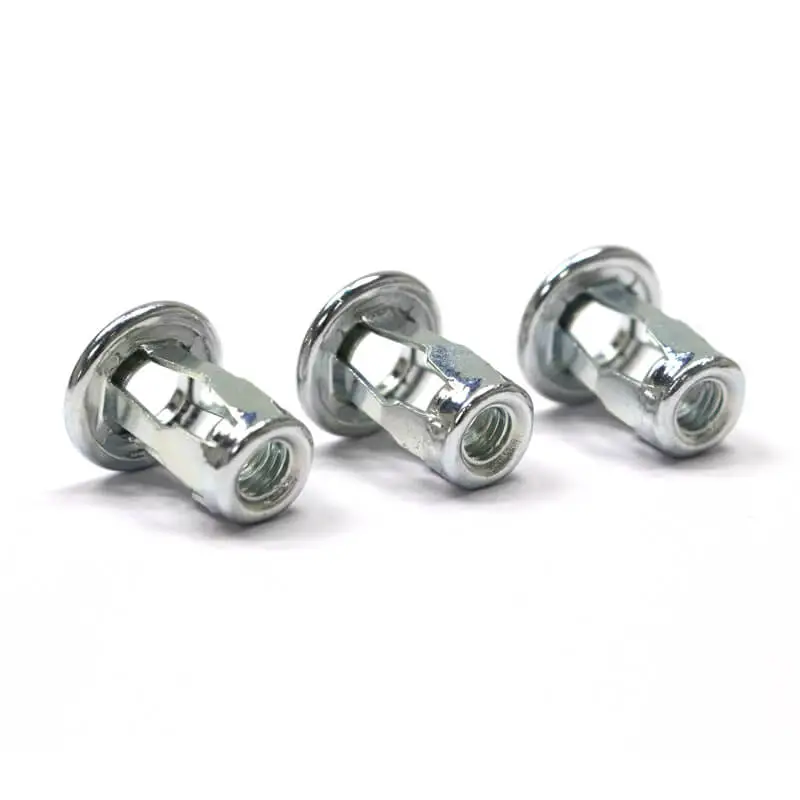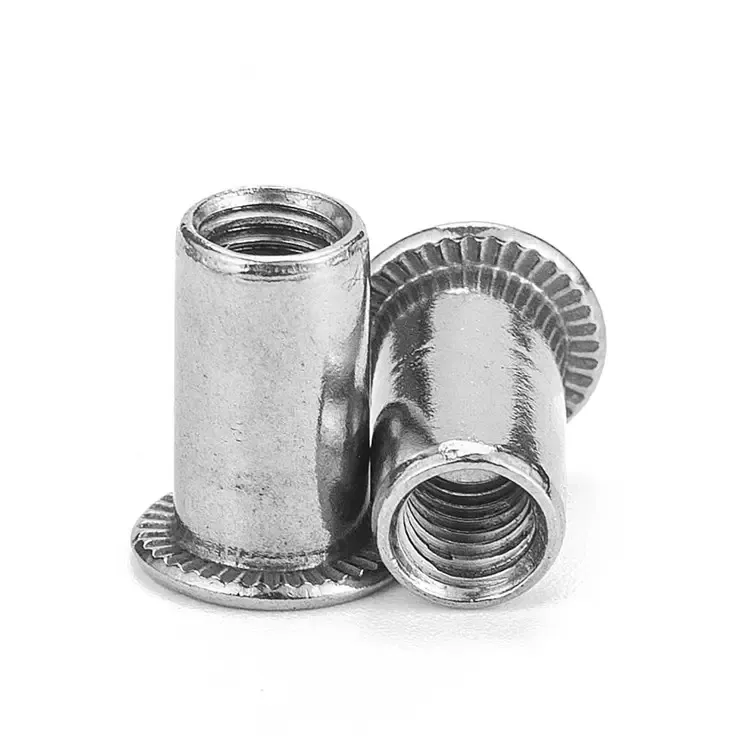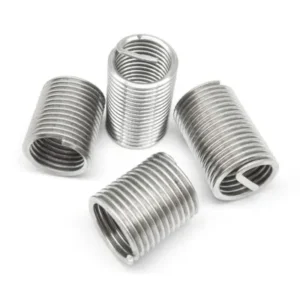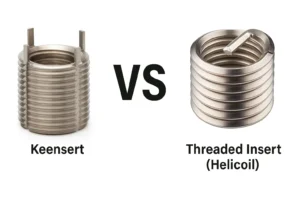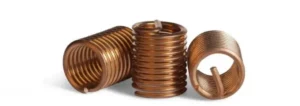Jack Nut vs Rivet Nut: Which is Better for Your Project?
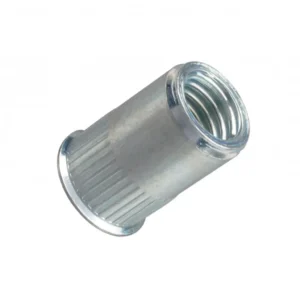
Leading Rivet Nut Manufacturer and Supplier in China

Jack Nut vs Rivet Nut, which one fits your project needs better? Choosing between jack nuts and rivet nuts depends on your project requirements, including material type. Here’s a comparison to help you decide which fastener is better for your needs.
Table of Contents

Jack Nut (also known as insert nuts, clinching nuts, or threaded inserts) are a type of fastener. They can create strong connections in materials like sheet metal, plastic, fiberglass, and other softer or thinner materials. These materials cannot hold threads on their own, making jack nuts an ideal solution.
Jack nuts are often provide a durable threaded insert for screws, bolts, or other fasteners. This enables secure attachment points in thin or weak materials.
Key Features of Jack Nuts
1. Flanged Body
The flanged body of a jack nut enhances its functionality by improving load distribution, preventing material damage, and providing stable installation. Additionally, it plays a crucial role in ensuring the nut remains securely fixed in place after installation. As a result, it is ideal for a wide range of applications in thin or soft materials.
2. External Serrations or Knurling
The outer surface of jack nuts is typically serrated or knurled. These features help the nut grip the material tightly, preventing rotation or loosening after installation. They provide a secure grip in the base material. This feature ensures the nut stays in place under stress, preventing loosening, shifting, or rotation. Moreover, jack nuts contribute to ease of installation and long-term durability in various materials. As a result, they are ideal for applications where strong, lasting threaded connections are needed.
3. Internal Threads
Jack nuts come with internal threads, which allow for the attachment of screws, bolts, or other fasteners. The internal threads are designed to accept standard screws or bolts, creating a secure attachment point in materials that cannot be directly tapped. Additionally, jack nuts ensure compatibility with standard screws or bolts, enhance the durability of the connection.
4. Installation Process
They are installed by using a special tool that compresses the nut’s body, causing it to expand and anchor itself firmly in place. The external serrations or knurls ensure the nut stays in position.
Do You Have Any Questions?
Let Us Solve Your Problem
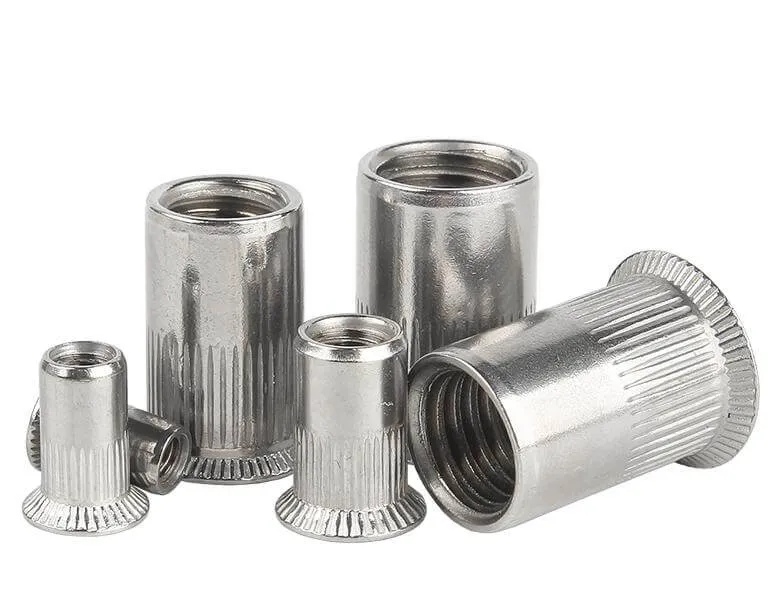
Rivet Nuts are a type of fastener. They can create a strong, durable threaded connection in materials that cannot hold threads on their own. These include materials like sheet metal, plastic, or composite materials.
In fact, rivet nuts are commonly used in applications where a strong, secure threaded insert is needed but where traditional threading is not feasible due to the material’s thickness or softness. The installation principle works by expansion or deformation within the base material. As a result, the expansion provides a secure, reliable thread for attaching bolts, screws, or other fasteners.
Types of Rivet Nuts
Rivet nuts are available in various materials and designs to suit different applications. The most common types include those made from different materials, such as steel, aluminum, and stainless steel, as well as various head designs, such as countersunk and flat head rivet nuts.
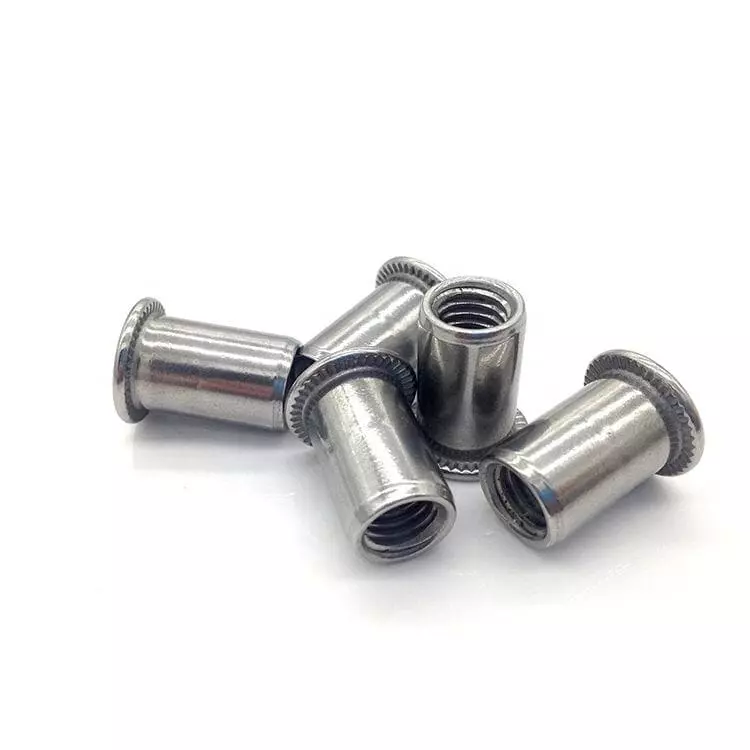
- Material: Made from carbon steel or alloy steel.
- Key Features: Steel rivet nuts offer high strength, durability, and resistance to wear and corrosion.
- Applications: Ideal for heavy-duty applications, automotive and construction industries, and other applications requiring high load-bearing capacity.
- Advantages: High tensile strength, cost-effective for high-performance applications.

- Material: Made from aluminum alloy.
- Key Features: Aluminum rivet nuts are lightweight, corrosion-resistant, and have good thermal conductivity. They are softer than steel rivet nuts but still offer reasonable strength for many applications.
- Applications: Used in lightweight applications, including aerospace, electronics, and automotive industries where weight reduction is important.
- Advantages: Lightweight, good corrosion resistance, and easy to install.

- Material: Made from stainless steel (typically 304 or 316 grade).
- Key Features: Stainless steel rivet nuts offer excellent corrosion resistance, making them ideal for use in marine, chemical, and outdoor environments. They also provide high strength and durability.
- Applications: Used in harsh environments, marine, food processing, and chemical industries, as well as high-strength applications.
- Advantages: Corrosion-resistant, durable, and long-lasting performance, especially in wet or salty environments.

- Design: The countersunk head has a conical shape that allows the rivet nut to sit flush with the surface when installed. This design is perfect for applications where a smooth or flat finish is required.
- Key Features: These rivet nuts are designed to create a flush finish, making them ideal for use in aesthetic applications or where external parts must not interfere with the fastener.
- Applications: Common in aerospace, automotive, and electronics where a clean, flush surface is needed.
- Advantages: Ideal for flush mounting and aesthetic purposes. It provides a smooth, finished appearance.
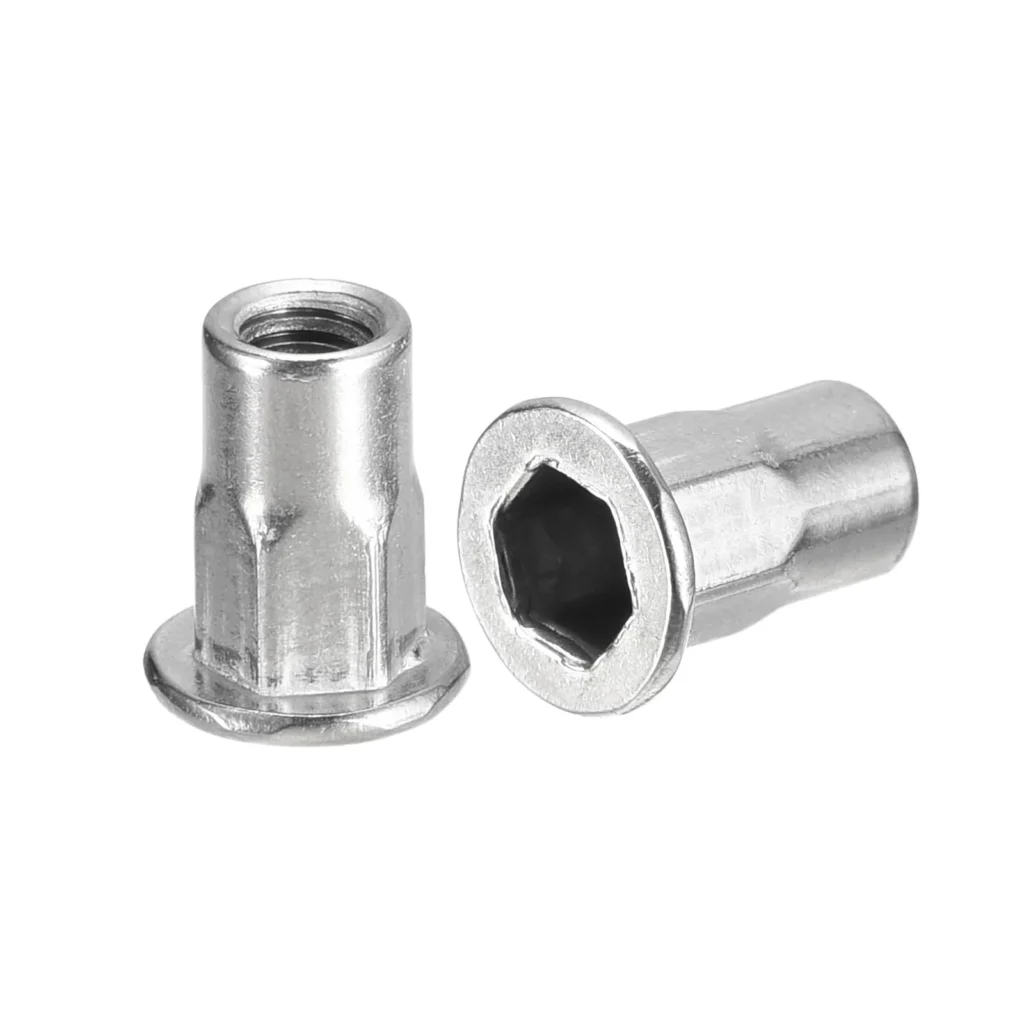
- Design: These rivet nuts have a flat flange on top, which provides a larger contact surface with the material. The flat flange offers a stronger connection and is useful for distributing stress more evenly.
- Key Features: The flat head allows for better load distribution and is typically used in applications where the appearance isn’t as important, but strength is.
- Applications: Used in general assembly, automotive, furniture, and electrical equipment.
- Advantages: Provides good load distribution and easy installation in a wide range of materials.

- Design: A reduced head rivet nut features a smaller flange for installations in tight spaces. As a result, it expands radially inside the material to create a secure threaded connection and can be installed in blind holes.
- Key Features: The small flange design allows for a low-profile connection, making it ideal for limited spaces. Furthermore, it provides a strong and durable threaded connection through radial expansion.
- Applications: Commonly used in industries like automotive, electronics, furniture, aerospace, and appliances, where space is limited and a compact, strong connection is needed in blind holes or tight-fitting areas.
- Advantages: The compact design saves space, while the small flange offers a clean, minimal appearance. In addition, it maintains strength and durability, making it versatile for various applications that require secure, low-profile connections.
Types of Rivet Nuts - Conclusion
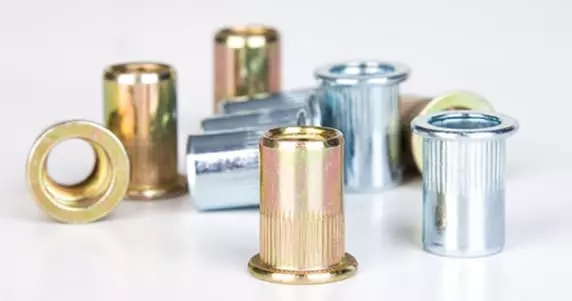
Choosing the right type of rivet nut depends on the material and strength requirements of your project. It also depends on the environmental conditions and aesthetic preferences.
- Steel rivet nuts are best for heavy-duty applications.
- Aluminum rivet nuts and stainless steel rivet nuts offer corrosion resistance and are suitable for lightweight or harsh environments.
- Countersunk head rivet nuts and flat head rivet nuts are ideal for applications requiring flush mounting or load distribution.
- Knurled rivet nuts are perfect for soft materials and high-vibration applications.
Do You Have Any Questions?
Let Us Solve Your Problem
What's the Difference - Jack Nut vs Rivet Nut
| Feature | Jack Nuts | Rivet Nuts |
| Design | Flanged body, external serrations/knurls | Flanged body, smooth or mild knurling |
| Installation | Compressed by a clinching tool | Expanded by a rivet nut tool (swaging) |
| Strength | Moderate strength for light-duty applications | High strength for heavy-duty applications |
| Material Compatibility | Thin materials, plastics, light sheet metal | Thicker materials, steel, aluminum |
| Applications | Electronics, furniture, automotive, light-duty | Automotive, aerospace, industrial machinery |
| Ease of Installation | Easy, cost-effective, basic tools | Requires more specialized tools |
| Aesthetic Finish | Flush finish, suitable for visible areas | May have a visible flange or slight protrusion |
| Cost | Generally less expensive | Generally more expensive |
Design and Structure Comparison
Jack Nuts:
Jack nuts typically have a flanged body with internal threads and external serrations or knurls. As a result, the serrations help anchor the nut securely to the base material once installed. In addition, the flange is usually thin and designed to be compressed during installation, gripping the base material tightly.
Rivet Nuts:
Rivet nuts also have a flanged body and internal threads, however, the flange is generally thicker compared to jack nuts. Furthermore, they usually have a smooth outer surface or mild knurling to help anchor them in place. During installation, it is designed to be swaged (or deformed), expanding the body to form a strong mechanical grip on the base material.
Installation Process Comparison
Jack Nuts:
Jack nuts are typically installed using a clinching tool or a manual tool that compresses the body of the jack nut. As a result, this causes the nut to grip the material and form a secure connection.
Rivet Nuts:
Rivet nuts are typically installed with a rivet nut tool. This tool can be manual, pneumatic, or hydraulic. It works by applying a radial force to the body. Consequently, this force causes the body to expand. The expansion creates a strong grip inside the material. Moreover, the flange of the rivet nut acts as a stopper. This ensures the nut is securely fixed in place and prevents excessive deformation of the material.
Material Compatibility and Application Comparison
Jack Nuts:
Jack nuts suit thin or soft materials like plastic and sheet metal, where threads cannot be directly tapped. Additionally, people commonly use them in applications where aesthetic appearance matters, as they offer a clean, flush installation. Thus, you often find jack nuts in electronics, furniture, automotive, and consumer products that require moderate strength.
Rivet Nuts:
In contrast, rivet nuts work well in heavier applications that need a more robust threaded connection. Consequently, they suit thicker materials like steel or aluminum. As a result, industries like automotive, aerospace, construction, and machinery widely use rivet nuts. These industries demand connections that can endure high stress, vibrations, or heavy loads.
Jack Nut vs Rivet Nut: Conclusion
- Jack nuts are ideal for light-duty, aesthetic-sensitive applications with thinner or softer materials.
- Rivet nuts are better for high-strength, heavy-duty applications, particularly in thicker or industrial-grade materials where durability and performance are critical.
Do You Have Any Questions?
Let Us Solve Your Problem
Jack Nut vs Rivet Nut : How to Choose the Right Type
| When to Choose | Jack Nuts | Rivet Nuts |
| Material Type | Thin or soft materials (plastics, sheet metal) | Thicker, stronger materials (steel, aluminum) |
| Installation Condition | Blind installation required | High load-bearing and durability needed |
| Load Requirements | Moderate load-bearing applications | High vibration resistance required |
| Environment | Cost-effective, light-duty applications | Harsh environments (marine, industrial) |
| Ease of Installation | Easy to install and requires low force | Heavy-duty applications needing robust connections |

As a leading fastener manufacturer in China with more than 15 years in the industry, Rivetfix are committed to providing first-class quality fasteners and responsive services to the world.
Our wide selection of rivet nuts, including standard, blind, and specialty types, allows you to find the perfect solution for your project. Trust Rivetfix for superior service, high-performance products, and expert advice tailored to your fastening needs. We can select the most suitable fasteners according to your project needs, and provide product customization services.
Contact us for project advice and the latest rivet nut quote!
Get High Quality Rivet Nuts Quote!
Send Your Rivet Nut Request
For more than 20 years, Rivetfix has helped customers solve many rivet nuts sourcing needs and technical challenges.
Have a question? Contact us and we’ll provide you with the perfect solution.
